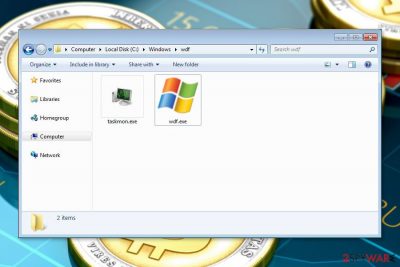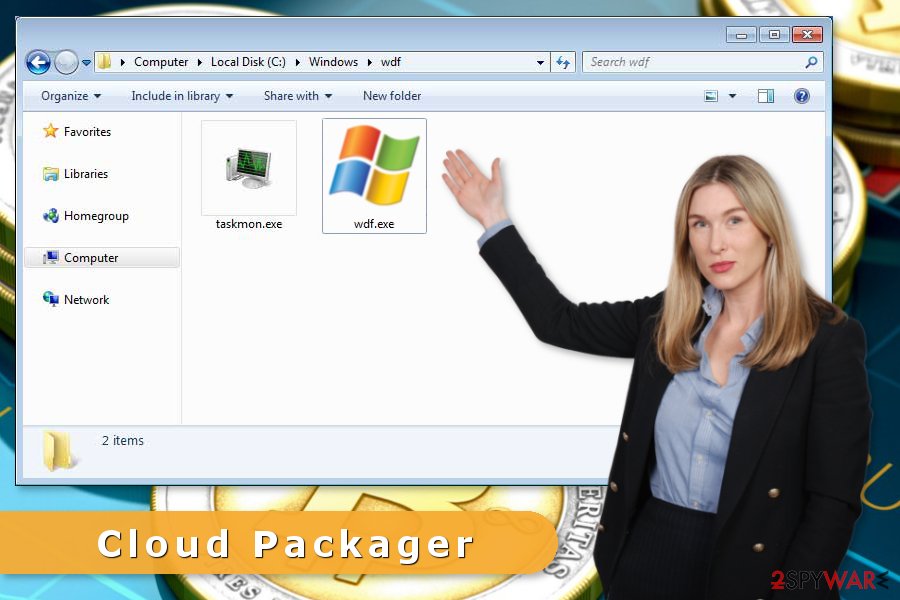Cloud Packager virus (Free Instructions) - Simple Removal Guide
Cloud Packager virus Removal Guide
What is Cloud Packager virus?
Cloud Packager miner hides under the names of Windows processes

Cloud Packager is a Trojan horse that is designed to mine digital currency (Bitcoin, Monero, Dashcoint, etc.) by using affected computer’s CPU[1] and GPU processing power. Generally, mining is not illegal activity. However, this malicious program uses computer’s resources without asking user’s permission; and it’s definitely illegal.
Cloud Packager miner is mostly spread via cracks, adware bundles, and other potentially unwanted programs. In this way, the trojan can sneak inside the system unnoticed. However, the sings of the malware attack are clear – extremely slow computer’s performance.
Once Cloud Packager virus enters the system, it creates two miners that have different purposes. One of them – NvProfileUpdater64.exe – is designed to use computer’s GPU or video card. The second one – wdf.exe – uses computer’s CPU processing power. Both of these processes are visible in the Task Manager.
However, the NvProfileUpdater64.exe miner uses the name of NVIDIA[2] driver profile updater in order to trick users that it’s a legit process. The wdf.exe uses the name of the Microsoft to hide its malicious tasks. But keep in mind that legit processes cannot use 70% or more of the computer’s resources.Thus, seeing such entries is the main sign that your computer is used for mining cryptocurrency.
Other signs that your computer might be infected with Cloud Packager virus are:
- Appearance of the Cloud Packager 1.13.0.59 uninstaller;
- Windows OS becomes sluggish and runs slowly;
- Programs do not open or freeze;
- Unknown processes run in the Task Manager using a high percentage of the computer’s resources.
If you recognized at least one of these symptoms, you should scan the system with FortectIntego or another malware removal tool to remove Cloud Packager miner from the device. The high usage of the computer’s resources might result in overheat. When your PC works in the high temperature for a long time, it might burn out.
Thus, this cyber threat might cause physical damage to your device. It goes without saying that you should not delay Cloud Packager removal in order to avoid losing your computer as well as all the important data saved in it.

Miner program spread in software bundles
The Cloud Packager hijack might occur if you download freeware or shareware incorrectly. It means that when you download some free program from the Internet, you have to monitor the installation process and make sure that you do not agree to download any “optional downloads.” For this reason, you should follow safety tips created by Los Virus[3] security team:
- always choose reliable download sources;
- read EULA, Privacy Policy or other provided documents before installing an application. If these entries are not provided, do not install the app;
- choose Advanced/Custom installation instead of Quick/Recommended;
- read notifications in each of the steps and unmark pre-selected additional downloads (if there are any).
Removal of the Cloud Packager Trojan
If you suspect that mining trojan may have been installed on your device, you should obtain a reputable anti-malware software and run a full system scan. Tools like FortectIntego or Malwarebytes can quickly remove Cloud Packager as well as other PUPs or cyber threats that may have been installed on your device as well.
However, if for some reason you cannot run automatic Cloud Packager removal, you should reboot the computer to the Safe Mode with Networking. Sometimes malicious programs can block access to security software to stay longer on the device. However, the instructions below will show you how to disable the virus first.
Getting rid of Cloud Packager virus. Follow these steps
Manual removal using Safe Mode
If you cannot run automatic Cloud Packager removal, follow these steps:
Important! →
Manual removal guide might be too complicated for regular computer users. It requires advanced IT knowledge to be performed correctly (if vital system files are removed or damaged, it might result in full Windows compromise), and it also might take hours to complete. Therefore, we highly advise using the automatic method provided above instead.
Step 1. Access Safe Mode with Networking
Manual malware removal should be best performed in the Safe Mode environment.
Windows 7 / Vista / XP
- Click Start > Shutdown > Restart > OK.
- When your computer becomes active, start pressing F8 button (if that does not work, try F2, F12, Del, etc. – it all depends on your motherboard model) multiple times until you see the Advanced Boot Options window.
- Select Safe Mode with Networking from the list.

Windows 10 / Windows 8
- Right-click on Start button and select Settings.

- Scroll down to pick Update & Security.

- On the left side of the window, pick Recovery.
- Now scroll down to find Advanced Startup section.
- Click Restart now.

- Select Troubleshoot.

- Go to Advanced options.

- Select Startup Settings.

- Press Restart.
- Now press 5 or click 5) Enable Safe Mode with Networking.

Step 2. Shut down suspicious processes
Windows Task Manager is a useful tool that shows all the processes running in the background. If malware is running a process, you need to shut it down:
- Press Ctrl + Shift + Esc on your keyboard to open Windows Task Manager.
- Click on More details.

- Scroll down to Background processes section, and look for anything suspicious.
- Right-click and select Open file location.

- Go back to the process, right-click and pick End Task.

- Delete the contents of the malicious folder.
Step 3. Check program Startup
- Press Ctrl + Shift + Esc on your keyboard to open Windows Task Manager.
- Go to Startup tab.
- Right-click on the suspicious program and pick Disable.

Step 4. Delete virus files
Malware-related files can be found in various places within your computer. Here are instructions that could help you find them:
- Type in Disk Cleanup in Windows search and press Enter.

- Select the drive you want to clean (C: is your main drive by default and is likely to be the one that has malicious files in).
- Scroll through the Files to delete list and select the following:
Temporary Internet Files
Downloads
Recycle Bin
Temporary files - Pick Clean up system files.

- You can also look for other malicious files hidden in the following folders (type these entries in Windows Search and press Enter):
%AppData%
%LocalAppData%
%ProgramData%
%WinDir%
After you are finished, reboot the PC in normal mode.
Remove Cloud Packager using System Restore
This method might also help to disable the virus in order to remove it:
-
Step 1: Reboot your computer to Safe Mode with Command Prompt
Windows 7 / Vista / XP- Click Start → Shutdown → Restart → OK.
- When your computer becomes active, start pressing F8 multiple times until you see the Advanced Boot Options window.
-
Select Command Prompt from the list

Windows 10 / Windows 8- Press the Power button at the Windows login screen. Now press and hold Shift, which is on your keyboard, and click Restart..
- Now select Troubleshoot → Advanced options → Startup Settings and finally press Restart.
-
Once your computer becomes active, select Enable Safe Mode with Command Prompt in Startup Settings window.

-
Step 2: Restore your system files and settings
-
Once the Command Prompt window shows up, enter cd restore and click Enter.

-
Now type rstrui.exe and press Enter again..

-
When a new window shows up, click Next and select your restore point that is prior the infiltration of Cloud Packager. After doing that, click Next.


-
Now click Yes to start system restore.

-
Once the Command Prompt window shows up, enter cd restore and click Enter.
Finally, you should always think about the protection of crypto-ransomwares. In order to protect your computer from Cloud Packager and other ransomwares, use a reputable anti-spyware, such as FortectIntego, SpyHunter 5Combo Cleaner or Malwarebytes
How to prevent from getting trojans
Access your website securely from any location
When you work on the domain, site, blog, or different project that requires constant management, content creation, or coding, you may need to connect to the server and content management service more often. The best solution for creating a tighter network could be a dedicated/fixed IP address.
If you make your IP address static and set to your device, you can connect to the CMS from any location and do not create any additional issues for the server or network manager that needs to monitor connections and activities. VPN software providers like Private Internet Access can help you with such settings and offer the option to control the online reputation and manage projects easily from any part of the world.
Recover files after data-affecting malware attacks
While much of the data can be accidentally deleted due to various reasons, malware is one of the main culprits that can cause loss of pictures, documents, videos, and other important files. More serious malware infections lead to significant data loss when your documents, system files, and images get encrypted. In particular, ransomware is is a type of malware that focuses on such functions, so your files become useless without an ability to access them.
Even though there is little to no possibility to recover after file-locking threats, some applications have features for data recovery in the system. In some cases, Data Recovery Pro can also help to recover at least some portion of your data after data-locking virus infection or general cyber infection.
- ^ Dan Goodin. A surge of sites and apps are exhausting your CPU to mine cryptocurrency. Ars Technica. IT news, reviews, and analysis.
- ^ Tae Kim. Nvidia to launch graphics cards specifically designed for digital currency mining. CNBC. News website.
- ^ Los Virus. Los Virus. Spanish cyber security news.





















